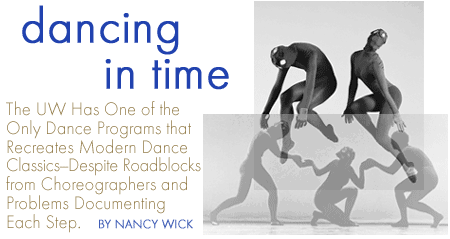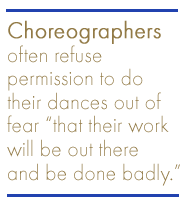
Chamber Dance Company member Chris Kaufman recreates Doris Humphrey's 1920 classic Soaring. Photo by Joel Levin.

"They often tell me in the beginning that they don't understand modern dance, that they feel dumb," she said. "They feel like there's a message there and they're not getting it. So we spend 10 weeks demystifying this thing. They learn there might be a message, there might be lots of messages, there might be no message, they're not dumb."
Watching the dances in the studio—where the dancers are in rehearsal clothes and about two yards from those watching—teaches something else, Wiley says. "You hear the breathing, you get the sweat, you see how hard it is. Then I talk to the audience a little bit. Then a couple of weeks later, these same people go to the concert where they can't hear the breathing, they can't see the sweat, but they see the totality of it. It's adding those two experiences together that's a treat beyond belief. There's a depth that the people who come to both get to experience that is close to dancing it."
The CDC has been performing historical dances at the UW for 15 years, and in that time the dance world has begun to pay more attention to the preservation of such dances. The New York Public Library for the Performing Arts has, for example, created the Collaborative Editing Project to Document Dance, which pairs choreographers with videographers to work on recording significant dances in such a way that they can be easily reconstructed.

And the American Dance Legacy Institute at Brown University is tackling the problem of accessibility by inviting choreographers to create "repertory etudes"—short dances based on their signature works. These dances are videotaped and can be obtained by anyone for a modest fee. Each etude package includes a videotape of the dance, including instructional and coaching footage; a CD of the music; a notated score; costume and lighting suggestions; and a resource guide with additional information, such as historical notes, bibliography or improvisational exercises.
None of this will prevent choreographers or their heirs from holding tight to dances or charging high fees for reconstruction, but the recent case of Martha Graham—who died in 1991—should lead them to think about their legacy. The Martha Graham Company was unable to perform her dances for two years because of a disagreement between her heir, Ronald Protas, and the company's parent organization, the Martha Graham Center for Contemporary Dance, over who owned the dances.
After a lengthy court battle that ended this fall, the center won. The judge ruled that when Graham sold her school in 1956 to a nonprofit foundation, she forfeited ownership of her work in exchange for a regular salary and thus became an "employee for hire."
 No choreographer wants to lose control of his or her work; yet, is it more important to hand the dances down to someone who will make sure they are performed "correctly" for a fee or to make sure the work continues to be performed widely? While acknowledging that choreographers should receive fair compensation for their creations, Wiley and Cooper argue that important dances should be as available as possible for reinterpretation by new generations of dancers.
No choreographer wants to lose control of his or her work; yet, is it more important to hand the dances down to someone who will make sure they are performed "correctly" for a fee or to make sure the work continues to be performed widely? While acknowledging that choreographers should receive fair compensation for their creations, Wiley and Cooper argue that important dances should be as available as possible for reinterpretation by new generations of dancers.
"Performing a dance is getting to know it in a way that you could look at it 100 times and never know it in that particular way," Wiley says. "So in their years here CDC members might perform in eight or nine historical figures' work and that's a deep, deep insight into history."
"Dances change every time they're performed anyway," Cooper adds. "Even classical ballets like Swan Lake that have supposedly been handed down intact look very different today than when they were created."
Cooper thinks the dances have value to non-dancers too. "We were studying German expressionism in the Creative Context class one year because the CDC was performing work from that period," she says. "One of the most gratifying pieces of feedback I ever got was when a student told me she had learned so much about the Holocaust and the rise of the Nazis in that class. I tell them we're not just studying dance history; we're looking at human history through the lens of dance."
—Nancy Wick, '97, is the editor of University Week, the UW's faculty/staff newspaper.
Go To: Page 1 | Page 2 | Page 3